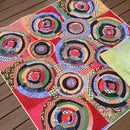Introduction: Fabric Printing With Citra-Solv
Step 1: What You Need:
1. Citra-Solv. They have an incredible website with product info, art stuff, order info, go here. If you live in the States you can find it at just about any Whole Foods. But save yourself a trip and go to their website if you live far from town. There are great ideas there that I didn't know about until after I wrote this 'ible.
2. Small shallow bowl
3. Cheap 1" or larger paint brush
4. Fabric you want to print on (this should be the smoothest fabric you can find - usually that means a tight weave, but experiment - if you don't have a lot of detail such as a photo you can use a looser
weave fabric.
5. An iron
6. Access to a copier that uses toner (most do, like a Xerox or Cannon etc.) This means a copier that ONLY prints in black.
7. Newspaper or something to protect your dining room table if need be
8. A big spoon, wooden or metal
9. Some pins
10. Images you want to print
Step 2: About Citra-Solv:
All that matters to you and I is that it is pleasant to smell, but you still need to use it in a well ventilatied room or outside, and you should try not to get it on your hands - it doesn't burn but it's not good for you. Keep it out of your eyes obviously - OK, I read the side of the bottle. A little bit anyway.
There is more info about this in the ironing section - be sure to read that too.
Step 3: What to Do Next:
You can use images that you have on your computer (I am assuming I don't have to say anything about copyright stuff here, you know the drill by now - DONT COPY other's work without permission). Print them in black in white or color - it doesn't much matter as you are going to be making copies of them on the copier that will be in black and white.
You are then going to lay the image upside down, meaning that you will be looking at the back of the paper. Now secure it to the fabric with those pins from the supply list.
Step 4: Brushing on the Citra-Solv
Step 5: Burnishing
Your printing/burnishing surface must be fairly hard - not as hard as a table and not as soft as a towel on top of a table; newspapers and a piece of fabric give about the right hardness. Think about how the paper would bend if you were burnishing on a really soft surface. Think about your lack of surface area on a really hard surface. Look for something to give you an in-between surface.
Step 6: Peeking
But the reason I want you to peek at this point is because you are just practicing. Peek enough times and you will soon get to the point that you won't have to.
Step 7: Ironing
Iron on a cloth to protect your ironing board. You are protecting it from smelling like Citra-Solv forever and also in case any ink goes right through your fabric.
I don't think it is a good idea to breath Citra-Solve fumes as they evaporate from the hot iron so you should do this outside or in a well ventilated room or wear a real gas mask. When I am working with it I tend to print many, many images on a piece of fabric so I wear a real gas mask, don't let this deter you from tying this 'ible. I use a lot so I take more precautions. It doesn't say anything on the bottle about it being harmful if inhaled (it does smell pretty good too) so it must not be, but it's just common sense to me. (Yes, I read the side of the bottle after all).
Step 8: Hints
Poke just a small hole in the top of the Citra-Solv bottle so the stuff doesn't evaporate too fast and so you have more control as you pour it into that shallow dish.
Iron your fabric before you start printing because you really need a flat smooth surface.
If you are printing on a T-shirt put something inside the shirt so you don't have ink bleeding through to the back of the shirt.
I know you will ask but no, you cannot use this technique with stuff you print out from your inkjet printer. I tried it and nothing happens, no ink transfers because no ink dissolves. Laser printers I do not know about - try it and let us know.
An Addtional Note: I tried this technique with a color laser copy (not to be confused with a color laser print, which I have not tried yet) and there was no transfer at all. The color copy (from Kinkos) was a few years old. A brand new copy may have a dfferent effect.
Remember that if you are printing an image with words on it that they (the words) will print in reverse. Actually the image will print in reverse too. You probably already knew that but just in cae you didn't, make them backwards before you make your copy so you can read them. Some really great copiers have this feature - so if yours does, use it. You will only forget one time.











